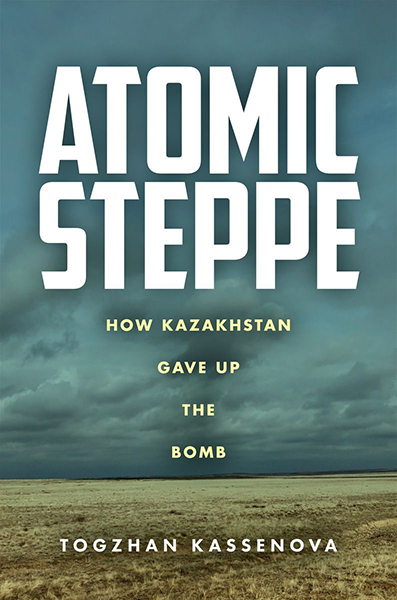Book Review: ‘Atomic Steppe: How Kazakhstan Gave Up the Bomb’
Kazakhstan – for 30 years a reliable security partner for the West – has said little of the Soviet nuclear legacy that befell it upon the breakup of the Soviet Union. This previously untold story of its abandonment of nuclear weapons is now told in a new book, ‘Atomic Steppe: How Kazakhstan Gave Up the Bomb’ by Togzhan Kassenova.
The book is so much more than the title suggests. Through a historical lens, Dr Kassenova explores the fault lines in relations between Russia, Central Asian states, other former Soviet republics and the West. It is a thrilling account of one of the most significant geopolitical events in history: Kazakhstan abandoning its nuclear capacity in pursuit of peace and stability. The book is the culmination of more than a decade of painstaking research by the author, whose own father was one of the architects of Kazakhstan’s nuclear policy.

The development of nuclear weapons from scientific, political, technical, logistical and social perspectives is laid out in chilling detail. Aspects include what motivations drove scientists to explore unleashing the energy locked in atoms, to how they were treated by the Military hierarchy of the Soviet Union, to how they themselves treated the unwitting victims of their experiments.
The competition between the two superpowers to increase yields year after year brought huge costs (yield being the energy released in a detonation). Air detonations from testing caused immense harm to local populations, the environment, plants and animals. Yet both the Soviet Union and the USA pursued development with barely any consideration of the harm to unwitting victims who were exposed to such detonations, the radioactive fallout, and fatal contamination of their food and water supplies. This commonality of suffering gave birth to the Nevada-Semipalatinsk movement where natives of Nevada, USA and Kazakhstan travelled, campaigned and dined together during a historic peace march through Kazakhstan. The symbol of this movement was a Native American elder sharing a peace pipe with a Kazakh elder. This is a highly moving account of the subaltern peoples of both superpowers finding common ground as victims and empowering each other’s resistance.
The Soviet Union’s leadership under Stalin and his successors disregarded Kazakh concerns about the health impact on civilians and the environment. Internal campaigns within the Soviet military, medical and political circles to address concern also failed. Medical staff were involved in the decades of secrecy as cancer rates soared, and remained high throughout 40 years of nuclear testing in Kazakhstan. Many of the stories of what effects people suffered are harrowing. And yet today there are still people suffering the consequences. One of the few contemporary political points in the book is that more must be done to support this fourth generation of victims.
As the Soviet Union broke up, four republics inherited the nuclear arsenal: Russia, Belarus, Kazakhstan and Ukraine. The Kazakh leader, Nursultan Nazarbayev, had opted, it seems from the beginning, for a non-nuclear Kazakhstan. He faced enormous challenges: possession of nuclear weapons was seen at the time as a guarantor of a nation’s security and some argued as much; the weapons and materials were under Russian military control and Nazarbayev wanted to ensure that they would not be used from his country against his will or without his knowledge. Also posing issues was the physical security of the weapons and materials, as well as international pressures to sell weapons and materials. Nazarbayev deftly handled all of these challenges and was regarded by the USA as the most capable leader in the post-Soviet space (he had been asked by Gorbachev to be the Prime Minister of the Soviet Union just before its collapse). One of the most spectacular episodes was codenamed Operation Sapphire in which Nazarbayev and his team worked in complete secrecy with the US Government to safely move 600kg of highly enriched uranium from a storage facility in Kazakhstan for safe keeping and processing in the USA. This operation has all the hallmarks of a great spy thriller and is a permanent testimony that Kazakhstan demonstrated what a reliable security partner it is for the West.
Kazakhstan showed global leadership when it embraced the Non-Proliferation Treaty by willingly giving up nuclear weapons and being committed to being a non-nuclear state. Kazakhstan’s responsible decision gave strength to the Non-Proliferation Treaty and showed the world that a non-nuclear choice can give a country a better path of development. That this has so rarely featured in our discourse in the West is a senseless oversight.
Dr Kassenova’s book is superb in many ways. In the mid-80s I was a schoolboy in the English suburbs, I remember the films we watched about nuclear war and the drills we carried out at school should the UK be attacked by the Soviet Union. The Cold War’s end offered the hope of a more peaceful future. Sadly, conventional war has continued unabated, but we have not seen nuclear war, at least not yet. This is not an accident and Dr Kassenova credits a few key individuals who worked for decades to prevent the proliferation of nuclear weapons and materials. This book is a must-read for anyone interested in the geopolitics of nuclear weapons and how they have shaped the world in which we live.
Afzal Amin
